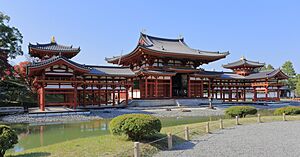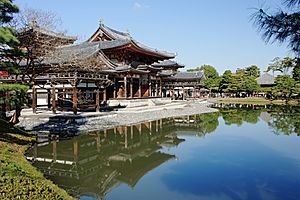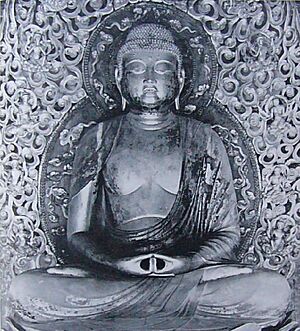Byōdō-in facts for kids
Quick facts for kids Byōdō-in |
|
|---|---|
|
平等院
|
|

Phoenix Hall, a National Treasure
|
|
| Religion | |
| Affiliation | Independent |
| Deity | Amida Nyorai (Amitābha) |
| Location | |
| Location | 116 Ujirenge, Uji, Kyoto Prefecture |
| Country | Japan |
| Architecture | |
| Founder | Fujiwara no Yorimichi |
| Completed | 1052 |
Byōdō-in (平等院, "Temple of Equality") is a famous Buddhist temple in Uji, a city in Kyoto Prefecture, Japan. It was built a very long time ago, in the late Heian period (around 1052). This temple is special because it belongs to two different Buddhist groups: the Jōdo-shū (Pure Land) and Tendai-shū sects.
Contents
A Look Back: History of Byōdō-in
The Byōdō-in temple started out as a country home in 998. It belonged to a powerful government official named Minamoto no Shigenobu. After he passed away, a very important leader of the Fujiwara clan, Fujiwara no Michinaga, bought the property.
His son, Fujiwara no Yorimichi, changed the home into a Buddhist temple in 1052. This means the Byōdō-in Temple and its amazing Buddha statues are nearly 1,000 years old! It is now one of Japan's World Heritage Sites.
Around the year 1052, many people in East Asia believed that a difficult time, called the "Age of Dharma Decline" (or Mappo), was beginning. This idea made many nobles and monks become even more devoted to Buddhism. They especially believed in the idea of a "Buddhist Pure Land" – a peaceful place.
Because of this belief, the Amida-do Hall, also known as the Phoenix Hall, was finished the next year. Inside this hall sits a 2.4-meter-tall statue of the Amida Buddha. This statue was made by Jōchō, who was thought to be the best Buddhist sculptor of his time.
Sadly, in 1336, a samurai warrior named Masashige Kusunoki was fighting a war. A fire started around Byōdō-in Temple, and many of its buildings burned down. Only a few survived.
Over time, Byōdō-in Temple grew into a much larger complex. New buildings were added, like Jodo-in Temple in 1496 and Rakan-do Hall in 1640.
The Phoenix Hall got a big makeover in 1670, including new front doors. Later, in 1698, a large fire damaged Uji and Byōdō-in Temple again. The walls and doors of the Phoenix Hall were ruined. But this damage made people even more determined to protect and fix the Phoenix Hall.
During the Meiji Period (1868–1912) and Showa Period (1926–1989), the Phoenix Hall had more major renovations. In 1951, the Phoenix Hall and the Amida Buddha statue were named National Treasures of Japan. The Phoenix Hall was even chosen to be on the back of the Japanese 10 yen coin! Other items, like the Temple Bell and statues, were also named National Treasures.
In 1994, Byōdō-in Temple became a UNESCO World Heritage site. It is part of the "Historic Monuments of Ancient Kyoto." Even today, work continues to preserve the garden, the Amida Buddha statue, and the Phoenix Hall.
The most famous building is the Phoenix Hall (鳳凰堂, Hōō-dō), built in 1053. It's the only original building left from that time. It stands beautifully by a pond. Other buildings were lost in the civil war of 1336.
Exploring the Temple Complex
The Amazing Phoenix Hall
The Phoenix Hall is the main building at Byōdō-in. It has a central hall with two "wing" corridors on each side and a "tail" corridor at the back. It looks a bit like a bird with its wings spread out. Inside the central hall is the Amida Buddha statue. On the roof, you'll see statues of the Chinese phoenix, called hōō in Japanese.
This building is very important because it's one of the few examples left from the Fujiwara Regent Period. It shows the Chinese style of architecture that was popular back then.
The Phoenix Hall was finished in 1053. Even though its official name is Amida-dō, people started calling it Hōō-dō, or Phoenix Hall, in the Edo period. This name comes from its bird-like shape and the phoenix statues on its roof.
Inside the Phoenix Hall, the large Amida Buddha statue sits on a high platform. The statue is made of Japanese cypress wood and covered in gold leaf. It was created by Jōchō, a famous sculptor. He used a special technique called yosegi, where he carved many pieces of wood and then joined them together.
The statue is about three meters tall from its face to its knees. It sits in a calm, meditating position. Its hands are placed in its lap, palms up, with thumbs and forefingers forming a circle. This hand gesture, called 'Inso', means deep concentration and peace. The white dot on its forehead, called the Urna, is like a "Third Eye." It symbolizes wisdom and the ability to see everyone's suffering. The Buddha's gentle smile shows his enlightenment and kindness. He looks slightly downward, showing both meditation and mercy towards visitors. His hair is short and curled, with a pointed topknot called Ushnisha.
On the walls of the hall, there are small carvings of heavenly beings. These are believed to have joined Amida Buddha when he came from the Western Paradise to guide believers' souls to Paradise. There are also Raigō paintings on the wooden doors. These paintings show the Amida Buddha coming down from heaven and are early examples of Yamato-e, a Japanese style of painting. They even show scenes from around Kyoto.
In front of the Phoenix Hall is a beautiful Jōdo-shiki garden with a pond. The temple faces east, which suggests that visitors need to cross the pond to reach the "Buddhist Pure Land." These gardens are considered a nationally important Historic Site and Place of Scenic Beauty.
The Kannon-do Hall
The Kannon-do Hall is another important building. It was built around 1230. Its design is simple and follows an older style from the Tenpyo period (710-794). This hall is currently being renovated and is not open to visitors.
Japan honors the Phoenix Hall's long history and importance. You can see its image on the 10 yen coin, and the 10,000 yen note features the phoenix image from its roof. In 1994, UNESCO named the Phoenix Hall a World Heritage Site. It is part of the "Historic Monuments of Ancient Kyoto". The Phoenix Hall, the Amida statue, and other items at Byōdō-in are all National Treasures of Japan.
There's even a half-size copy of the temple in Hawaii! It was finished in 1968 in the Valley of the Temples Memorial Park on O'ahu.
Yorin-an Shoin Residence
This building is a residence and also a small temple within the Byōdō-in area. It was built in the early Edo Period (around the 1600s). Its roof is made of Japanese cypress bark. It's believed that some of the building materials came from the old Momoyama Castle. The paintings inside were done by artists from the Kano studio.
Hoshokan Museum
The Hoshokan Museum is a modern museum that opened in 2001. It was built to better protect and display the national treasures from Byōdō-in Temple. These treasures include the Temple Bell, 26 statues of the Praying Bodhisattva on Clouds, and the pair of phoenixes from the Phoenix Hall's rooftop.
Most of the museum is built underground. This way, it blends in with the temple's traditional buildings. Even though it's underground, the museum gets plenty of natural sunlight, making the exhibition halls bright and comfortable.
To visit the temple grounds and the museum, it costs 700 yen for adults. If you want to go inside the Phoenix Hall, which was restored in 2014, it costs an extra 300 yen. The tours inside the hall are in Japanese, but you can get an English guide book.
Byodoin Tea Salon Toka
If you're visiting Byōdō-in Temple, you can also stop by the Byodoin Tea Salon Toka. Here, you can try real Uji green tea. The tea leaves come from tea fields in Uji City or nearby farms. Expert Japanese Tea Instructors will serve you tea with great care. The salon is open every day except Tuesday, from 10:00 AM to 4:30 PM.
Gallery
See also
- Battle of Uji (1180)
- List of National Treasures of Japan (temples)
- List of National Treasures of Japan (sculptures)
- List of National Treasures of Japan (paintings)
- List of National Treasures of Japan (crafts-others)
- For an explanation of terms concerning Japanese Buddhism, Japanese Buddhist art, and Japanese Buddhist temple architecture, see the Glossary of Japanese Buddhism.
- Shinden-zukuri










